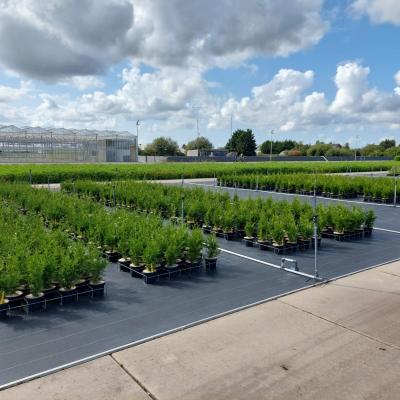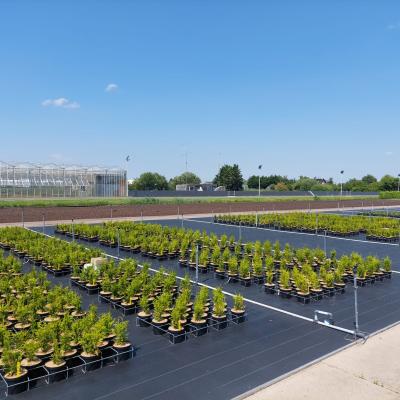In the Netherlands, Delphy has conducted research into the use of various peat-free potting soils based on local residual flows. Ranging from various types of compost from the Boskoop area to fermented corn, biochar, Miscanthus, dried ditch sludge and thick manure fraction.
Last years Delphy and growers already gained experience with substrates based on coconut, bark, wood fibre and RHP compost. The research conducted last year clearly, focussed on new alternative raw materials from local residual streams. These local residual streams can be interesting in terms of price and contributes to a lower CO2 footprint compared to raw materials that come from far away. To test whether streams materials are an option as a peat substitute, twelve different peat-free substrate mixtures were made for the trial. The treenursery crop Thuja was potted in these mixtures.
A local network is being developed in Greenport Boskoop with tree growers from Greenport Boskoop, the municipality of Alphen aan de Rijn and companies from various sectors. They are not only looking at the possibilities of residual streams in substrate, but will also conduct research together with Delphy into the use of these streams in open ground cultivations.
Trial setup
The trial started May last year. Twelve different mixtures were made at the Delphy Research Nursery with alternative raw materials ranging from different types and doses of compost from the Boskoop area to fermented corn, biochar, Miscanthus, dry manure fraction and dried ditch sludge. In these mixtures, Thuja plicata ‘Gelderland’ planting material was repotted. During the cultivation, the plant growth on the different mixtures was compared with a standard peat-free mixture that is now also used in practice. Consisting of 30% coconut grit, 20% coconut fibre, 20% wood fibre, 20% bark and 10% compost. The most experimental mixture was the ‘Boskoop mixture’ consisting of 30% wood fibre, 30% thick manure fraction, 30% Miscanthus and 10% Biochar from the pyrolysis of beech chips.
The trial was carried out in three repetitions. In addition, two watering strategies were used: a standard watering adjusted to the standard mixture and a strategy with a higher watering dose.
During cultivation, the EC and pH were frequently monitored. At the end of cultivation (December), the fresh weight of the plants was determined by cutting the plants just above the ground and weighing the crop.
First results
The Thujas had grown well in 9 treatments, the crop colour was also good. The differences between the treatments were small. Only the following treatments showed 10-20% less weight: treatment with 30% Miscanthus in the mixture, the Boskoop mixture (see before) and the plants with 30% thick manure fraction in the mixture. The difference compared to the standard was larger with normal watering than under wetter conditions.
The fact that the plants had grown less well in these mixtures does not mean that thick manure fraction and Miscanthus cannot be good raw materials for potting soil. The total composition of the mixture influences the growth of the plants. When adjusting the total mixture, it may be possible that 30% Miscanthus or 30% dry manure in a substrate is feasible. This will be examined in follow-up research in 2025. Conversely, residual streams that gave good growth in this trial are not yet directly suitable for practice as a peat substitute. In this trial, 20% dried ditch sludge in the mixture instead of 20% compost gave a comparable growth result. Fermented corn in the substrates with biobin compost from the region also gave comparable growth as the standard.
It is still too early to start using these residual flows directly as a peat substitute. The products are not (yet) covered by the Dutch substrate RHP certification. For controlled and safe use, it is important that the composition is constant and the product must also meet hygiene and phytosanitary requirements. In addition, the results for a crop that is more sensitive to pH or root problems, for example, may be different. The good growth results with biobin compost were remarkable. In 2025, Delphy started to set up a new substrate trial. There will always be a difference between substrate raw materials in terms of suitability for easy crops and sensitive crops.
Residual waste streams in open ground treenurseries
Within CLOSECYCLE, not only potting soil is being looked at. With tree growers from Greenport Boskoop, the municipality of Alphen aan den Rijn and companies from various sectors, research is also being set up into the use of residual flows in the open ground. Results will be shared in CLOSECYCLE. This can provide new insights.


